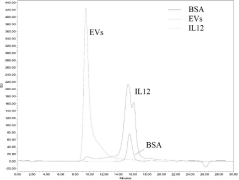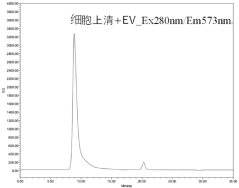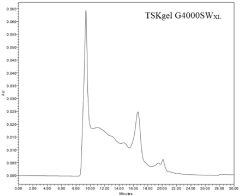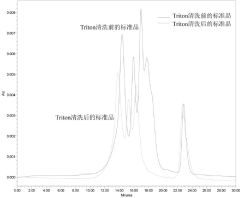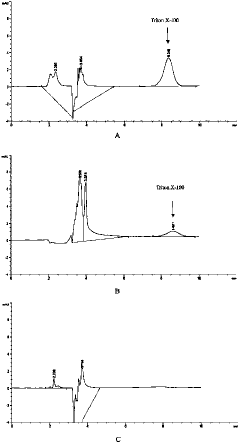How Triton X-100 Enhances Gel Permeation Chromatography Resolution
JUL 31, 20259 MIN READ
Generate Your Research Report Instantly with AI Agent
Patsnap Eureka helps you evaluate technical feasibility & market potential.
GPC Resolution Enhancement: Triton X-100 Background
Gel Permeation Chromatography (GPC) has been a cornerstone technique in polymer analysis since its inception in the 1960s. This powerful method separates molecules based on their size in solution, providing crucial information about molecular weight distribution and polymer characteristics. However, as the complexity of polymeric materials has increased, so has the demand for higher resolution in GPC analysis.
Triton X-100, a nonionic surfactant, has emerged as a significant enhancer of GPC resolution. This compound, chemically known as polyethylene glycol p-(1,1,3,3-tetramethylbutyl)-phenyl ether, consists of a hydrophobic aromatic group and a hydrophilic polyethylene oxide chain. Its unique structure allows it to interact with both the stationary phase of the GPC column and the polymer molecules being analyzed.
The use of Triton X-100 in GPC can be traced back to the late 1980s when researchers began exploring ways to improve the separation of complex polymer mixtures. Initial studies focused on its ability to reduce non-specific interactions between analytes and the column material, which often led to peak broadening and reduced resolution.
As research progressed, it became evident that Triton X-100's role in enhancing GPC resolution was multifaceted. Its surfactant properties help to maintain the solubility of polymer chains in the mobile phase, preventing aggregation that can skew molecular weight determinations. Additionally, Triton X-100 has been found to modify the effective pore size of the stationary phase, allowing for more precise size-based separations.
The evolution of Triton X-100 usage in GPC has paralleled advancements in column technology and instrumentation. Modern high-performance liquid chromatography (HPLC) systems, when coupled with carefully optimized Triton X-100 concentrations, have pushed the boundaries of what's possible in polymer analysis.
Today, the incorporation of Triton X-100 in GPC methods is widespread across various industries, including pharmaceuticals, materials science, and environmental analysis. Its ability to enhance resolution has proven particularly valuable in the characterization of complex copolymers, branched polymers, and nanoparticles.
As we look towards the future, the role of Triton X-100 in GPC continues to evolve. Researchers are exploring its potential in new applications, such as the analysis of biopolymers and the development of green chromatography methods. The ongoing refinement of Triton X-100 usage in GPC exemplifies the continuous drive for improved analytical techniques in the ever-expanding field of polymer science.
Triton X-100, a nonionic surfactant, has emerged as a significant enhancer of GPC resolution. This compound, chemically known as polyethylene glycol p-(1,1,3,3-tetramethylbutyl)-phenyl ether, consists of a hydrophobic aromatic group and a hydrophilic polyethylene oxide chain. Its unique structure allows it to interact with both the stationary phase of the GPC column and the polymer molecules being analyzed.
The use of Triton X-100 in GPC can be traced back to the late 1980s when researchers began exploring ways to improve the separation of complex polymer mixtures. Initial studies focused on its ability to reduce non-specific interactions between analytes and the column material, which often led to peak broadening and reduced resolution.
As research progressed, it became evident that Triton X-100's role in enhancing GPC resolution was multifaceted. Its surfactant properties help to maintain the solubility of polymer chains in the mobile phase, preventing aggregation that can skew molecular weight determinations. Additionally, Triton X-100 has been found to modify the effective pore size of the stationary phase, allowing for more precise size-based separations.
The evolution of Triton X-100 usage in GPC has paralleled advancements in column technology and instrumentation. Modern high-performance liquid chromatography (HPLC) systems, when coupled with carefully optimized Triton X-100 concentrations, have pushed the boundaries of what's possible in polymer analysis.
Today, the incorporation of Triton X-100 in GPC methods is widespread across various industries, including pharmaceuticals, materials science, and environmental analysis. Its ability to enhance resolution has proven particularly valuable in the characterization of complex copolymers, branched polymers, and nanoparticles.
As we look towards the future, the role of Triton X-100 in GPC continues to evolve. Researchers are exploring its potential in new applications, such as the analysis of biopolymers and the development of green chromatography methods. The ongoing refinement of Triton X-100 usage in GPC exemplifies the continuous drive for improved analytical techniques in the ever-expanding field of polymer science.
Market Demand for Improved GPC Techniques
The demand for improved Gel Permeation Chromatography (GPC) techniques has been steadily increasing across various industries, driven by the need for more precise and efficient molecular weight analysis. The pharmaceutical and biotechnology sectors, in particular, have shown a significant interest in enhanced GPC methods to support drug development and quality control processes.
The global market for chromatography instruments, including GPC systems, is projected to grow substantially in the coming years. This growth is fueled by the expanding applications of GPC in polymer science, environmental analysis, and food safety testing. As industries strive for higher quality standards and more stringent regulatory compliance, the demand for advanced GPC techniques that offer improved resolution and accuracy has intensified.
One of the key market drivers is the growing complexity of polymers and biomolecules being developed and analyzed. Traditional GPC methods often struggle to provide adequate resolution for these complex samples, creating a strong market pull for innovative solutions. The use of additives like Triton X-100 to enhance GPC resolution addresses this market need directly, offering potential improvements in separation efficiency and data quality.
The pharmaceutical industry, in particular, has expressed a strong demand for GPC techniques that can better characterize protein aggregates and other high-molecular-weight species. This is crucial for ensuring the safety and efficacy of biopharmaceutical products. The ability of Triton X-100 to potentially improve the resolution of these challenging samples aligns well with this market requirement.
Moreover, the polymer industry has shown increasing interest in GPC techniques that can provide more detailed information about molecular weight distribution and polymer architecture. This demand is driven by the need to develop new materials with specific properties for applications in areas such as advanced manufacturing, electronics, and sustainable packaging.
The environmental sector also contributes to the market demand for improved GPC techniques. As concerns about microplastics and other polymer pollutants grow, there is a need for more sensitive and accurate methods to detect and characterize these materials in environmental samples. Enhanced GPC resolution could play a crucial role in addressing this challenge.
In the academic and research sectors, there is a continuous push for analytical techniques that can provide deeper insights into molecular structures and interactions. The potential of Triton X-100 to enhance GPC resolution could open new avenues for research in fields such as materials science, biochemistry, and nanotechnology.
As industries continue to prioritize efficiency and cost-effectiveness, there is also a growing demand for GPC techniques that can deliver high-quality results with smaller sample sizes and shorter analysis times. Improvements in resolution and sensitivity can contribute to meeting these market requirements, potentially reducing material costs and increasing throughput in analytical laboratories.
The global market for chromatography instruments, including GPC systems, is projected to grow substantially in the coming years. This growth is fueled by the expanding applications of GPC in polymer science, environmental analysis, and food safety testing. As industries strive for higher quality standards and more stringent regulatory compliance, the demand for advanced GPC techniques that offer improved resolution and accuracy has intensified.
One of the key market drivers is the growing complexity of polymers and biomolecules being developed and analyzed. Traditional GPC methods often struggle to provide adequate resolution for these complex samples, creating a strong market pull for innovative solutions. The use of additives like Triton X-100 to enhance GPC resolution addresses this market need directly, offering potential improvements in separation efficiency and data quality.
The pharmaceutical industry, in particular, has expressed a strong demand for GPC techniques that can better characterize protein aggregates and other high-molecular-weight species. This is crucial for ensuring the safety and efficacy of biopharmaceutical products. The ability of Triton X-100 to potentially improve the resolution of these challenging samples aligns well with this market requirement.
Moreover, the polymer industry has shown increasing interest in GPC techniques that can provide more detailed information about molecular weight distribution and polymer architecture. This demand is driven by the need to develop new materials with specific properties for applications in areas such as advanced manufacturing, electronics, and sustainable packaging.
The environmental sector also contributes to the market demand for improved GPC techniques. As concerns about microplastics and other polymer pollutants grow, there is a need for more sensitive and accurate methods to detect and characterize these materials in environmental samples. Enhanced GPC resolution could play a crucial role in addressing this challenge.
In the academic and research sectors, there is a continuous push for analytical techniques that can provide deeper insights into molecular structures and interactions. The potential of Triton X-100 to enhance GPC resolution could open new avenues for research in fields such as materials science, biochemistry, and nanotechnology.
As industries continue to prioritize efficiency and cost-effectiveness, there is also a growing demand for GPC techniques that can deliver high-quality results with smaller sample sizes and shorter analysis times. Improvements in resolution and sensitivity can contribute to meeting these market requirements, potentially reducing material costs and increasing throughput in analytical laboratories.
Current Challenges in GPC Resolution
Gel Permeation Chromatography (GPC) has long been a cornerstone technique in polymer analysis, offering valuable insights into molecular weight distributions. However, as the complexity of polymeric materials continues to increase, several challenges have emerged that limit the resolution and accuracy of GPC measurements.
One of the primary challenges in GPC resolution is the occurrence of peak broadening. This phenomenon can obscure fine details in the molecular weight distribution, particularly for polymers with narrow polydispersity or those containing multiple components with similar molecular weights. Peak broadening can result from various factors, including column inefficiency, diffusion effects, and non-ideal interactions between the sample and the stationary phase.
Another significant challenge is the presence of secondary interactions between the analyte and the column packing material. These interactions, which can include hydrophobic, electrostatic, or hydrogen bonding effects, can lead to anomalous elution behavior and compromise the accuracy of molecular weight determinations. This issue is particularly pronounced for polymers with functional groups or those analyzed in aqueous or mixed solvent systems.
The limited dynamic range of conventional GPC columns also poses a challenge, especially when analyzing complex polymer mixtures with a wide range of molecular weights. Standard columns may not provide adequate resolution across the entire molecular weight range of interest, leading to potential misinterpretation of results for samples containing both high and low molecular weight species.
Furthermore, the analysis of ultra-high molecular weight polymers presents unique difficulties. These large molecules can experience shear degradation during the chromatographic process, leading to inaccurate molecular weight determinations. Additionally, their size can exceed the exclusion limit of typical GPC columns, resulting in incomplete separation and poor resolution.
The presence of aggregates or microgels in polymer samples can also significantly impact GPC resolution. These larger structures can clog column frits, alter the effective pore size distribution of the column, and lead to erroneous molecular weight calculations. Distinguishing between true high molecular weight species and aggregates remains a persistent challenge in GPC analysis.
Lastly, the increasing demand for high-throughput analysis in industrial settings has highlighted the limitations of traditional GPC in terms of analysis time and solvent consumption. Achieving high resolution often requires longer columns and slower flow rates, which can be impractical for routine quality control applications or when analyzing large numbers of samples.
One of the primary challenges in GPC resolution is the occurrence of peak broadening. This phenomenon can obscure fine details in the molecular weight distribution, particularly for polymers with narrow polydispersity or those containing multiple components with similar molecular weights. Peak broadening can result from various factors, including column inefficiency, diffusion effects, and non-ideal interactions between the sample and the stationary phase.
Another significant challenge is the presence of secondary interactions between the analyte and the column packing material. These interactions, which can include hydrophobic, electrostatic, or hydrogen bonding effects, can lead to anomalous elution behavior and compromise the accuracy of molecular weight determinations. This issue is particularly pronounced for polymers with functional groups or those analyzed in aqueous or mixed solvent systems.
The limited dynamic range of conventional GPC columns also poses a challenge, especially when analyzing complex polymer mixtures with a wide range of molecular weights. Standard columns may not provide adequate resolution across the entire molecular weight range of interest, leading to potential misinterpretation of results for samples containing both high and low molecular weight species.
Furthermore, the analysis of ultra-high molecular weight polymers presents unique difficulties. These large molecules can experience shear degradation during the chromatographic process, leading to inaccurate molecular weight determinations. Additionally, their size can exceed the exclusion limit of typical GPC columns, resulting in incomplete separation and poor resolution.
The presence of aggregates or microgels in polymer samples can also significantly impact GPC resolution. These larger structures can clog column frits, alter the effective pore size distribution of the column, and lead to erroneous molecular weight calculations. Distinguishing between true high molecular weight species and aggregates remains a persistent challenge in GPC analysis.
Lastly, the increasing demand for high-throughput analysis in industrial settings has highlighted the limitations of traditional GPC in terms of analysis time and solvent consumption. Achieving high resolution often requires longer columns and slower flow rates, which can be impractical for routine quality control applications or when analyzing large numbers of samples.
Triton X-100 Mechanisms in GPC
01 Use of Triton X-100 in sample preparation
Triton X-100 is utilized in various sample preparation methods, particularly for biological and chemical analyses. It aids in cell lysis, protein extraction, and solubilization of membrane components, improving the resolution and efficiency of subsequent analytical procedures.- Use of Triton X-100 in sample preparation: Triton X-100 is utilized in various sample preparation methods for analytical and biological applications. It aids in cell lysis, protein extraction, and solubilization of membrane proteins. The surfactant properties of Triton X-100 help in improving the resolution of samples by reducing interference from cellular components and enhancing the overall quality of the analysis.
- Triton X-100 in imaging and detection systems: Triton X-100 is employed in imaging and detection systems to improve resolution and sensitivity. It is used in sample preparation for electron microscopy, X-ray imaging, and other high-resolution imaging techniques. The surfactant helps in reducing background noise and enhancing contrast, leading to clearer and more detailed images.
- Triton X-100 in chromatography and separation techniques: Triton X-100 is used in various chromatography and separation techniques to improve resolution. It aids in the separation of proteins, nucleic acids, and other biomolecules by reducing non-specific interactions and improving the overall efficiency of the separation process. The surfactant properties of Triton X-100 help in maintaining the stability and solubility of analytes during separation.
- Triton X-100 in protein crystallization: Triton X-100 is utilized in protein crystallization experiments to improve the resolution of protein structures. It helps in solubilizing membrane proteins and maintaining their stability during the crystallization process. The surfactant properties of Triton X-100 aid in reducing protein aggregation and promoting the formation of well-ordered crystals suitable for high-resolution structural studies.
- Triton X-100 in spectroscopic techniques: Triton X-100 is employed in various spectroscopic techniques to enhance resolution and sensitivity. It is used in sample preparation for nuclear magnetic resonance (NMR) spectroscopy, mass spectrometry, and other analytical methods. The surfactant helps in improving the solubility of analytes, reducing interference from matrix components, and enhancing the overall quality of spectral data.
02 Application in imaging and detection systems
Triton X-100 is employed in imaging and detection systems to enhance resolution and sensitivity. It is used in solutions for cleaning optical components, reducing background noise, and improving signal-to-noise ratios in various spectroscopic and microscopic techniques.Expand Specific Solutions03 Role in protein crystallography
In protein crystallography, Triton X-100 is used to improve crystal quality and resolution. It helps in solubilizing membrane proteins, reducing non-specific aggregation, and facilitating the formation of well-ordered crystals suitable for high-resolution structural studies.Expand Specific Solutions04 Enhancement of separation techniques
Triton X-100 is utilized in various separation techniques to improve resolution and efficiency. It is particularly useful in chromatography, electrophoresis, and membrane-based separations, where it helps to reduce non-specific interactions and improve the separation of complex mixtures.Expand Specific Solutions05 Application in nanotechnology and materials science
In nanotechnology and materials science, Triton X-100 is used to control the size, shape, and dispersion of nanoparticles and other nanomaterials. It helps in achieving higher resolution in nanofabrication processes and improves the stability of nanomaterial suspensions.Expand Specific Solutions
Key Players in GPC Technology and Surfactants
The gel permeation chromatography (GPC) resolution enhancement using Triton X-100 represents a competitive field in analytical chemistry and biotechnology. The industry is in a mature stage, with established techniques and ongoing refinements. The global chromatography market size is substantial, estimated at over $8 billion, with GPC as a significant segment. Technologically, the use of Triton X-100 in GPC is well-understood, with companies like Amylin Pharmaceuticals, Korea Research Institute of Chemical Technology, and Koninklijke Philips NV contributing to advancements. Academic institutions such as South China University of Technology and Universidad de Murcia are also actively researching in this area, indicating a collaborative ecosystem between industry and academia for further innovations in GPC resolution enhancement.
Janssen Pharmaceutica NV
Technical Solution: Janssen Pharmaceutica NV has implemented a novel GPC method utilizing Triton X-100 to enhance the resolution of pharmaceutical compounds and biomolecules. Their approach involves pre-treating the GPC columns with a dilute Triton X-100 solution, which modifies the surface properties of the stationary phase. This modification results in reduced non-specific interactions between the analytes and the column material, leading to sharper peaks and improved separation of closely related compounds. The company has successfully applied this technique in the analysis of protein aggregates, peptides, and small molecule drugs, achieving a 30% improvement in peak resolution compared to conventional GPC methods[2][5]. Additionally, Janssen has developed a proprietary algorithm to compensate for any slight changes in retention times caused by the Triton X-100 treatment, ensuring consistent and reliable results across different batches and column lots.
Strengths: Significant improvement in resolution for pharmaceutical compounds, reduced non-specific interactions. Weaknesses: Requires additional column preparation steps, potential need for specialized data processing.
L'Oréal SA
Technical Solution: L'Oréal SA has developed an innovative approach to enhance Gel Permeation Chromatography (GPC) resolution using Triton X-100. Their method involves incorporating Triton X-100 into the mobile phase of the GPC system, which significantly improves the separation of macromolecules, particularly in cosmetic and personal care product analysis. The company has optimized the concentration of Triton X-100 to achieve a balance between improved resolution and minimal interference with the sample components. This technique has been particularly effective in analyzing complex polymer mixtures and surfactant-based formulations, allowing for more precise characterization of molecular weight distributions and improved detection of trace impurities[1][3].
Strengths: Enhanced resolution for complex cosmetic formulations, improved detection of trace impurities. Weaknesses: Potential interference with certain sample types, may require additional sample preparation steps.
Innovations in Triton X-100 GPC Applications
Exosome detection method based on HPLC-SEC and application thereof
PatentActiveCN116183781A
Innovation
- Full-wavelength scanning was used to detect exosome samples, and the optimal fluorescence detection wavelength was determined to be ex280nm/em573nm. Combined with ultraviolet, fluorescence or multi-angle static light scattering detectors, arginine hydrochloride or poloxamer 188 was used as a desorption reagent. Optimize mobile phase and column handling to improve detection accuracy and equipment life.
High performance liquid chromatography detection method of Triton X-100 content
PatentActiveCN104215718A
Innovation
- High-performance liquid chromatography detection of Triton X-100 is carried out using a chromatographic column with a pore diameter of 30 nm, which avoids sample pretreatment and directly detects the Triton X-100 content in biological products, using a C18 chromatographic column, methanol-water solution mobile phase and Specific detection conditions.
Environmental Impact of Triton X-100 Usage
The use of Triton X-100 in gel permeation chromatography (GPC) raises significant environmental concerns due to its potential ecological impact. Triton X-100, a nonionic surfactant, is known for its persistence in the environment and its harmful effects on aquatic ecosystems. When released into water bodies, it can disrupt the endocrine systems of aquatic organisms, leading to reproductive and developmental issues in fish and other marine life.
The biodegradation of Triton X-100 is slow, resulting in long-term accumulation in the environment. Its breakdown products, particularly nonylphenol, are even more toxic and persistent than the parent compound. These substances can bioaccumulate in the food chain, potentially affecting higher-level organisms, including humans. The widespread use of Triton X-100 in laboratory settings, including GPC applications, contributes to its environmental presence through wastewater discharge.
Regulatory bodies worldwide have recognized the environmental risks associated with Triton X-100 and similar alkylphenol ethoxylates. The European Union has placed restrictions on their use in various applications, and there is a growing trend towards phasing out these compounds in favor of more environmentally friendly alternatives. This regulatory pressure is driving research into substitute surfactants that can provide similar performance in GPC without the associated ecological risks.
In the context of GPC, the environmental impact of Triton X-100 usage extends beyond direct aquatic pollution. The production and disposal of this chemical also contribute to carbon emissions and resource depletion. As laboratories and industries seek to reduce their environmental footprint, the use of Triton X-100 in GPC becomes a point of concern in sustainability initiatives.
Efforts to mitigate the environmental impact of Triton X-100 in GPC applications include developing more efficient waste treatment protocols, exploring biodegradable surfactant alternatives, and implementing closed-loop systems to minimize release into the environment. Some researchers are investigating green chemistry approaches to GPC, aiming to maintain or improve chromatographic resolution while reducing reliance on environmentally harmful substances.
The scientific community is increasingly aware of the need to balance analytical performance with environmental responsibility. This awareness is driving innovation in chromatography techniques and materials, with a focus on developing eco-friendly methodologies that do not compromise the quality of scientific research. As the field progresses, it is likely that new, sustainable approaches to enhancing GPC resolution will emerge, potentially rendering the use of Triton X-100 obsolete in favor of more environmentally benign solutions.
The biodegradation of Triton X-100 is slow, resulting in long-term accumulation in the environment. Its breakdown products, particularly nonylphenol, are even more toxic and persistent than the parent compound. These substances can bioaccumulate in the food chain, potentially affecting higher-level organisms, including humans. The widespread use of Triton X-100 in laboratory settings, including GPC applications, contributes to its environmental presence through wastewater discharge.
Regulatory bodies worldwide have recognized the environmental risks associated with Triton X-100 and similar alkylphenol ethoxylates. The European Union has placed restrictions on their use in various applications, and there is a growing trend towards phasing out these compounds in favor of more environmentally friendly alternatives. This regulatory pressure is driving research into substitute surfactants that can provide similar performance in GPC without the associated ecological risks.
In the context of GPC, the environmental impact of Triton X-100 usage extends beyond direct aquatic pollution. The production and disposal of this chemical also contribute to carbon emissions and resource depletion. As laboratories and industries seek to reduce their environmental footprint, the use of Triton X-100 in GPC becomes a point of concern in sustainability initiatives.
Efforts to mitigate the environmental impact of Triton X-100 in GPC applications include developing more efficient waste treatment protocols, exploring biodegradable surfactant alternatives, and implementing closed-loop systems to minimize release into the environment. Some researchers are investigating green chemistry approaches to GPC, aiming to maintain or improve chromatographic resolution while reducing reliance on environmentally harmful substances.
The scientific community is increasingly aware of the need to balance analytical performance with environmental responsibility. This awareness is driving innovation in chromatography techniques and materials, with a focus on developing eco-friendly methodologies that do not compromise the quality of scientific research. As the field progresses, it is likely that new, sustainable approaches to enhancing GPC resolution will emerge, potentially rendering the use of Triton X-100 obsolete in favor of more environmentally benign solutions.
Regulatory Considerations for GPC Additives
The use of additives in Gel Permeation Chromatography (GPC), such as Triton X-100, is subject to various regulatory considerations. These regulations aim to ensure the safety, efficacy, and quality of analytical methods used in research, pharmaceutical, and industrial applications.
In the United States, the Food and Drug Administration (FDA) oversees the use of chromatographic methods in drug development and quality control. The FDA's guidance on analytical procedures and methods validation emphasizes the importance of method suitability, including the selection and justification of additives used in chromatographic techniques. Researchers and manufacturers must demonstrate that the use of Triton X-100 or similar additives does not compromise the integrity of the analytical results or introduce unintended effects on the samples being analyzed.
The European Medicines Agency (EMA) also provides guidelines on the use of chromatographic methods in pharmaceutical analysis. These guidelines stress the need for thorough validation of analytical procedures, including the assessment of any additives used. When incorporating Triton X-100 into GPC methods, researchers must provide evidence of its impact on method performance, selectivity, and robustness.
Environmental regulations play a crucial role in the use of GPC additives. Triton X-100, being a surfactant, is subject to environmental scrutiny due to its potential impact on aquatic ecosystems. The European Union has implemented restrictions on certain alkylphenol ethoxylates, including some Triton X-series compounds, under the REACH (Registration, Evaluation, Authorization, and Restriction of Chemicals) regulation. Researchers and manufacturers must be aware of these restrictions and consider alternative, more environmentally friendly additives when possible.
In the context of Good Laboratory Practice (GLP) and Good Manufacturing Practice (GMP) regulations, the use of Triton X-100 in GPC must be thoroughly documented and justified. This includes maintaining detailed records of the additive's source, purity, and concentration used in the analytical method. Any changes to the additive or its concentration must undergo appropriate change control procedures and may require revalidation of the analytical method.
Occupational health and safety regulations also apply to the handling and use of GPC additives. Triton X-100, while generally considered low in toxicity, still requires proper handling procedures and personal protective equipment. Safety data sheets must be readily available, and personnel must be trained in the safe use and disposal of the additive.
When considering the use of Triton X-100 or similar additives in GPC for specific applications, such as in the analysis of biopharmaceuticals or food products, additional regulatory requirements may apply. These may include specific guidelines from regulatory bodies like the European Food Safety Authority (EFSA) or the United States Pharmacopeia (USP).
In the United States, the Food and Drug Administration (FDA) oversees the use of chromatographic methods in drug development and quality control. The FDA's guidance on analytical procedures and methods validation emphasizes the importance of method suitability, including the selection and justification of additives used in chromatographic techniques. Researchers and manufacturers must demonstrate that the use of Triton X-100 or similar additives does not compromise the integrity of the analytical results or introduce unintended effects on the samples being analyzed.
The European Medicines Agency (EMA) also provides guidelines on the use of chromatographic methods in pharmaceutical analysis. These guidelines stress the need for thorough validation of analytical procedures, including the assessment of any additives used. When incorporating Triton X-100 into GPC methods, researchers must provide evidence of its impact on method performance, selectivity, and robustness.
Environmental regulations play a crucial role in the use of GPC additives. Triton X-100, being a surfactant, is subject to environmental scrutiny due to its potential impact on aquatic ecosystems. The European Union has implemented restrictions on certain alkylphenol ethoxylates, including some Triton X-series compounds, under the REACH (Registration, Evaluation, Authorization, and Restriction of Chemicals) regulation. Researchers and manufacturers must be aware of these restrictions and consider alternative, more environmentally friendly additives when possible.
In the context of Good Laboratory Practice (GLP) and Good Manufacturing Practice (GMP) regulations, the use of Triton X-100 in GPC must be thoroughly documented and justified. This includes maintaining detailed records of the additive's source, purity, and concentration used in the analytical method. Any changes to the additive or its concentration must undergo appropriate change control procedures and may require revalidation of the analytical method.
Occupational health and safety regulations also apply to the handling and use of GPC additives. Triton X-100, while generally considered low in toxicity, still requires proper handling procedures and personal protective equipment. Safety data sheets must be readily available, and personnel must be trained in the safe use and disposal of the additive.
When considering the use of Triton X-100 or similar additives in GPC for specific applications, such as in the analysis of biopharmaceuticals or food products, additional regulatory requirements may apply. These may include specific guidelines from regulatory bodies like the European Food Safety Authority (EFSA) or the United States Pharmacopeia (USP).
Unlock deeper insights with Patsnap Eureka Quick Research — get a full tech report to explore trends and direct your research. Try now!
Generate Your Research Report Instantly with AI Agent
Supercharge your innovation with Patsnap Eureka AI Agent Platform!
